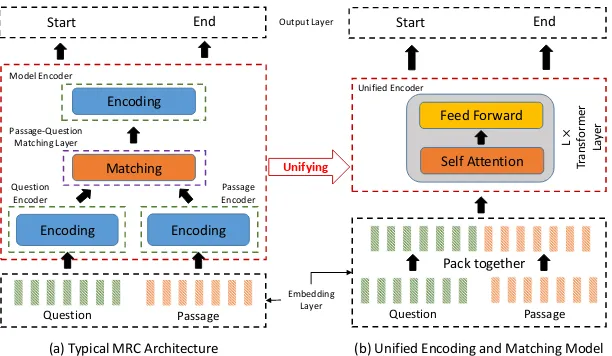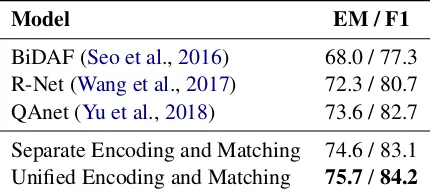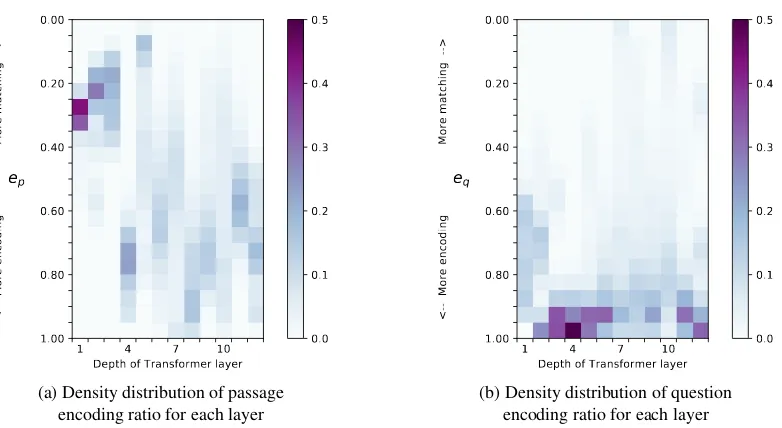Proceedings of the Second Workshop on Machine Reading for Question Answering, pages 14–18 14
Inspecting Unification of Encoding and Matching with Transformer:
A Case Study of Machine Reading Comprehension
Hangbo Bao†∗, Li Dong‡, Furu Wei‡, Wenhui Wang‡, Nan Yang‡,Lei Cui‡,Songhao Piao†andMing Zhou‡
†School of Computer Science, Harbin Institute of Technology
‡Microsoft Research
hangbobao@gmail.com,piaosh@hit.edu.cn
lidong1,fuwei,wenwan,nanya,lecu,mingzhou@microsoft.com
Abstract
Most machine reading comprehension (MRC) models separately handle encoding and match-ing with different network architectures. In contrast, pretrained language models with
Transformer layers, such as GPT (Radford
et al.,2018) and BERT (Devlin et al.,2018), have achieved competitive performance on MRC. A research question that naturally arises is: apart from the benefits of pre-training, how many performance gain comes from the
unified network architecture. In this work,
we evaluate and analyze unifying encoding and matching components with Transformer for the MRC task. Experimental results on SQuAD show that the unified model outper-forms previous networks that separately treat encoding and matching. We also introduce a metric to inspect whether a Transformer layer tends to perform encoding or matching. The analysis results show that the unified model learns different modeling strategies compared with previous manually-designed models.
1 Introduction
In spite of different neural network structures, en-coding and matching components are two basic building blocks for many NLP tasks like machine
reading comprehension (Rajpurkar et al., 2016;
Joshi et al.,2017). A widely-used paradigm is that the input texts are encoded into vectors, and then these vectors are aggregated to model interactions between them by matching layers.
Figure 1(a) shows a typical machine reading
comprehension model, encoding components sep-arately encode question and passage to vector
rep-resentations. Then, we obtain context-sensitive
representations for input words by considering the interactions between question and passage. Fi-nally, an output layer is used to predict the
prob-∗
Contribution during internship at Microsoft Research
ability of each token being the start or end
po-sition of the answer span. The encoding
lay-ers are usually built upon recurrent neural
net-works (Hochreiter and Schmidhuber, 1997; Cho
et al.,2014), and self-attention networks (Yu et al.,
2018). For the matching component, various
model components have been developed to fuse question and passage vector representations, such
as match-LSTM (Wang and Jiang, 2016),
co-attention (Seo et al., 2016; Xiong et al., 2016),
and self-matching (Wang et al.,2017). Recently,
Devlin et al.(2018) employ Transformer networks to pretrain a bidirectional language model (called BERT), and then fine-tune the layers on specific tasks, which obtains state-of-the-art results on MRC. A research question is: apart from the ben-efits of pretraining, how many performance gain comes from the unified network architecture.
In this paper, we evaluate and analyze unifying encoding and matching components with
Trans-former layers (Vaswani et al.,2017), using MRC
as a case study. As shown in Figure 1(b),
com-pared with previous specially-designed MRC net-works, we do not explicitly distinguish encoding stages and matching stages. We directly concate-nate input question and passage into one sequence at first, and append segment embeddings to word vectors in order to indicate whether each token is belong to question or passage. Next, the packed sequence is fed into a multi-layer Transformer net-work, which utilizes the self-attention mechanism to obtain contextualized representations for both question and passage. The first advantage is that the unified architecture enables the model to au-tomatically learn the encoding and matching strat-egy, rather than empirically specifying layers one by one. Second, the proposed method is conceptu-ally simpler than previous systems, which simpli-fies the model implementation.
Encoding Matching
Encoding Encoding
Question Passage
Start End
Question Passage
Pack together Self Attention Feed Forward
L
×
Tr
an
sf
orme
r
La
yer
Output Layer
Unified Encoder Model Encoder
Passage-Question Matching Layer
Question Encoder
Embedding Layer Passage Encoder
(a) Typical MRC Architecture (b) Unified Encoding and Matching Model Unifying
[image:2.595.147.453.60.238.2]Start End
Figure 1: An illustration of a typical MRC architecture and the unified encoding and matching model.
dataset (Rajpurkar et al.,2016), which is an
extrac-tive reading comprehension benchmark. Experi-mental results show that the unified model outper-forms previous state-of-the-art models that treat encoding and matching separately. The results
in-dicate that part of improvements of BERT (
De-vlin et al.,2018) attribute to the architecture used for end tasks. Moreover, we introduce a metric to inspect the ratio of encoding and matching for each layer. The analysis illustrates that the unified model learns different strategies to handle ques-tions and passages, which sheds lights on our fu-ture model design for MRC.
2 Unified Encoding and Matching Model
We focus on extractive reading comprehension in
the work. Given input passage xP and question
xQ, our goal is to predict the correct answer span
a = xPs · · ·xPe in the passage. The SQuAD v1.1 dataset assumes that the correct answer span is guaranteed to exist in the passage.
Figure 1(b) shows the overview of the unified
model1. We first pack the question and passage
into a single sequence. Then multiple
Trans-former (Vaswani et al.,2017) layers are employed
to compute the vector representations of question and passage together. Finally, an output layer is used to predict the start and end positions of
an-swer span. Compared with previous
specially-designed networks illustrated in Figure 1(a), the
model unifies encoding layers and matching layers by using multiple Transformer blocks. The self-attention mechanism is supposed to automatically
1The implementation and models are available at
github.com/addf400/UnifiedModelForSQuAD.
learn question-to-question encoding, passage-to-passage encoding, question-to-passage-to-passage matching, and passage-to-question matching.
2.1 Embedding Layer
For each word in questions and passages, the
vec-tor representation x is constructed by the word
embeddingxw, character embeddingxc, and
seg-ment embeddingxs. The character-level
embed-dings are computed in the similar way as (Yu et al.,
2018). The segment embeddings are vectors used
to indicate whether the word belongs to question or passage. The final representation is computed
via x = ϑ([xw;xc]) +xs, where ϑrepresents a
Highway network (Srivastava et al.,2015).
2.2 Unified Encoder
Given questionxQ and passage xP embeddings,
we first pack them together into a single sequence
[xQ1,· · · ,xQ|Q|,xP1,· · · ,xP|P|], which also denoted
as h0. Then an L-layer Transformer encoder is
used to encode the packed representations:
hl = Transformerl(hl−1)
wherel∈[1, L]is the depth.
two passage tokens can be viewed as passage en-coding. The attention weights across the ques-tion segment and the passage segment can be considered as question-to-passage or passage-to-question matching.
2.3 Output Layer
Inspired byYu et al.(2018), hidden vectors of
dif-ferent Transformer layershi,hj,hk (i = 6, j =
9, k = 12in our implementation) are used to
rep-resent the input. Moreover, we employ a
self-attentive method as in Wang et al. (2017) over
question vectors to obtain a question attentive
vec-torvq. Finally, we predict the probability of each
token being the start (ps) or end (pe) position of
the answer span:
ps= softmax(W1[hi;hivq;hj;hj vq])
pe= softmax(W2[hi;hivq;hk;hkvq])
where represents elementwise multiplication,
andW1,W2are parameters.
To train the model, we maximize the log likeli-hood of ground-truth start and end positions given input passage and question. At test time, we pre-dict answer spans approximately by greedy search.
3 Experiments
3.1 Experimental Setup
Dataset Stanford Question Answering Dataset
(SQuAD) (Rajpurkar et al.,2016) is composed of
over 100,000 instances created by crowdworkers. Every answer is constrained to be a continuous sub-span of the passage.
Settings We employ the spaCy toolkit to
prepro-cess data. We use300-dimensional GloVe
embed-dings (Pennington et al.,2014) to initialize word
vectors of both questions and passages, and keep them fixed during training. A special trainable to-ken<UNK>is used to represent out-of-vocabulary words. We randomly mask some words in the
pas-sage to<UNK>with 0.2 probability while training.
The dimension of character embedding and seg-ment embedding is 64 and 128, respectively. The number of Transformer layers used in our model
is12. For each Transformer layer, we set the
hid-den size to128, and use relative position
embed-ding (Shaw et al.,2018) whose clipping distance
is16. The number of the attention heads is8.
During training, the batch size is 32 and the number of the max training epochs is 80. We use
Model EM / F1
BiDAF (Seo et al.,2016) 68.0 / 77.3
R-Net (Wang et al.,2017) 72.3 / 80.7
QAnet (Yu et al.,2018) 73.6 / 82.7
Separate Encoding and Matching 74.6 / 83.1
[image:3.595.309.525.63.160.2]Unified Encoding and Matching 75.7/84.2
Table 1: Performance of different models on SQuAD development set.
Adam (Kingma and Ba, 2015) as the optimizer
with β1 = 0.9, β2 = 0.999, = 10−6. We
use warmup over the first4,000steps, and keep
the learning rate fixed for the remainder of
train-ing. The learning rate is set to6×10−4. We
ap-ply the exponential moving average on all
train-able varitrain-ables with decay rate of 0.9999. Layer
dropout (Huang et al., 2016) is used in
Trans-former layers with 0.95 survival probability. We also apply dropout on word, character embeddings and each layers with dropout rate of 0.1, 0.05 and 0.1 respectively.
Comparison Models Apart from comparing
with previous state-of-the-art models (Seo et al.,
2016; Wang et al., 2017; Yu et al., 2018), we implement a baseline model that separately per-form encoding and matching. The same settings as above are used. The first three Transformer layers are utilized to encode passage and ques-tion separately. Then we add a passage-quesques-tion
matching layer following Yu et al. (2018), with
nine more Transformer layers used to compute the question-sensitive passage representations. To make a fair comparison, we only compare with the models that do not rely on pre-trained language
models (Peters et al., 2018;Radford et al.,2018;
Devlin et al.,2018).
3.2 Results
Exact match (EM) and F1 scores are two evalu-ation metrics for SQuAD. EM measures the per-centage of the prediction that matches the ground-truth answer exactly, while F1 measures the over-lap between the predicted answer answer and the ground-truth answer. The scores on the develop-ment set are evaluated by the official script.
As shown in Table 1, the unified model
1 4 7 10 Depth of Transformer layer 0.00
0.20
0.40
0.60
0.80
1.00
e
p<-- More encoding More matching -->
0.0 0.1 0.2 0.3 0.4 0.5
1 4 7 10
Depth of Transformer layer 0.00
0.20
0.40
0.60
0.80
1.00
e
q<-- More encoding More matching -->
0.0 0.1 0.2 0.3 0.4 0.5
(a) Density distribution of passage encoding ratio for each layer
[image:4.595.107.498.59.273.2](b) Density distribution of question encoding ratio for each layer
Figure 2: Density distribution of passage encoding ratioepand question encoding ratioeq for all attention heads
in Transformer layers. Vertical axis represents encoding ratio. Larger encoding ratio means that the layer performs more encoding, while smaller ratio value indicates more matching. Darker color means higher density, i.e., more attention heads’ encoding ratio values are within the range. The patterns show that the unified model learns
different modeling strategies compared with previous manually-designed networks (see Section3.3for details).
brings 1.1/1.1 absolute improvement on EM/F1 over the baseline that separately conducts encod-ing and matchencod-ing. The results indicate the unified model not only simplifies the model architecture, but also improves performance on SQuAD.
3.3 Analysis
We introduce passage encoding ratioepand
ques-tion encoding ratioeqto quantify the encoding and
matching strategies for each layer of the unified encoder. Let us take the question encoding ratio of
an attention head in thel-th Transformer layer for
example. Given the attention head’s self-attention
weight matrixA, the ratioeqis computed via:
sq|q= avgi,j∈Q{Ai,j}
sq|p = avgi∈Q,j∈P{Ai,j}
eq=sq|q/(sq|q+sq|p)
wheresq|q is the average question-to-question
at-tention weight, andsq|pis the average
passage-to-question attention weight. To be specific, ifeqis
close to1, it means that the layer tends to perform
question-to-question encoding. In contrast, if eq
is close to0, it indicates the layer performs more
passage-to-question matching. Similarly, we can
compute passage encoding ratioepas above.
As shown in Figure2, we compute passage
en-coding ratioep and question encoding ratioeqfor
all the attention heads on the development set,
and plot their density distributions for each Trans-former layer. We find that the unified model learns strategies that are clearly different from manually-designed architectures:
• Figure 2(a) shows that the first three layers
perform question-to-passage matching and the fourth layer conducts passage-to-passage encoding, while most previous models per-form passage encoding first.
• Figure2(a) indicates that upper layers tend to
conduct more encoding than matching.
• Figure 2(b) shows that all layers tend to
perform question-to-question encoding than passage-to-question matching.
• Some layers are automatically learned to
per-form encoding and matching at the same time instead of separate modeling.
4 Conclusion
automatically learn strategies that are clearly dif-ferent from previous specially-designed models.
References
Kyunghyun Cho, Bart van Merrienboer, C¸ aglar
G¨ulc¸ehre, Dzmitry Bahdanau, Fethi Bougares,
Hol-ger Schwenk, and Yoshua Bengio. 2014. Learning
phrase representations using RNN encoder-decoder for statistical machine translation. InProceedings of the 2014 Conference on Empirical Methods in Nat-ural Language Processing, EMNLP 2014, October 25-29, 2014, Doha, Qatar, A meeting of SIGDAT, a Special Interest Group of the ACL, pages 1724– 1734.
Jacob Devlin, Ming-Wei Chang, Kenton Lee, and
Kristina Toutanova. 2018. BERT: pre-training of
deep bidirectional transformers for language under-standing.CoRR, abs/1810.04805.
Sepp Hochreiter and J¨urgen Schmidhuber. 1997.
Long short-term memory. Neural Computation, 9(8):1735–1780.
Gao Huang, Yu Sun, Zhuang Liu, Daniel Sedra, and
Kilian Q. Weinberger. 2016. Deep networks with
stochastic depth.CoRR, abs/1603.09382.
Mandar Joshi, Eunsol Choi, Daniel Weld, and Luke
Zettlemoyer. 2017. Triviaqa: A large scale distantly
supervised challenge dataset for reading comprehen-sion. InProceedings of the 55th Annual Meeting of the Association for Computational Linguistics (Vol-ume 1: Long Papers), pages 1601–1611. Associa-tion for ComputaAssocia-tional Linguistics.
Diederik P Kingma and Jimmy Ba. 2015. Adam: A
method for stochastic optimization. In Proceedings of the International Conference on Learning Repre-sentations (ICLR).
Jeffrey Pennington, Richard Socher, and
Christo-pher D. Manning. 2014. Glove: Global vectors for
word representation. InEmpirical Methods in Nat-ural Language Processing (EMNLP), pages 1532– 1543.
Matthew E. Peters, Mark Neumann, Mohit Iyyer, Matt Gardner, Christopher Clark, Kenton Lee, and Luke
Zettlemoyer. 2018. Deep contextualized word
rep-resentations. In Proceedings of the 2018 Confer-ence of the North American Chapter of the Associ-ation for ComputAssoci-ational Linguistics: Human Lan-guage Technologies, NAACL-HLT 2018, New Or-leans, Louisiana, USA, June 1-6, 2018, Volume 1 (Long Papers), pages 2227–2237.
Alec Radford, Karthik Narasimhan, Tim Salimans, and
Ilya Sutskever. 2018. Improving language
under-standing by generative pre-training.
Pranav Rajpurkar, Jian Zhang, Konstantin Lopyrev, and
Percy Liang. 2016. Squad: 100, 000+ questions for
machine comprehension of text. InProceedings of the 2016 Conference on Empirical Methods in Nat-ural Language Processing, EMNLP 2016, Austin, Texas, USA, November 1-4, 2016, pages 2383–2392.
Min Joon Seo, Aniruddha Kembhavi, Ali Farhadi,
and Hannaneh Hajishirzi. 2016. Bidirectional
at-tention flow for machine comprehension. CoRR, abs/1611.01603.
Peter Shaw, Jakob Uszkoreit, and Ashish Vaswani.
2018. Self-attention with relative position
represen-tations. In Proceedings of the 2018 Conference of the North American Chapter of the Association for Computational Linguistics: Human Language Tech-nologies, Volume 2 (Short Papers), pages 464–468. Association for Computational Linguistics.
Rupesh Kumar Srivastava, Klaus Greff, and J¨urgen
Schmidhuber. 2015. Highway networks. CoRR,
abs/1505.00387.
Ashish Vaswani, Noam Shazeer, Niki Parmar, Jakob Uszkoreit, Llion Jones, Aidan N. Gomez, Lukasz
Kaiser, and Illia Polosukhin. 2017. Attention is all
you need. InAdvances in Neural Information Pro-cessing Systems 30: Annual Conference on Neural Information Processing Systems 2017, 4-9 Decem-ber 2017, Long Beach, CA, USA, pages 6000–6010.
Shuohang Wang and Jing Jiang. 2016. Machine
com-prehension using match-lstm and answer pointer. CoRR, abs/1608.07905.
Wenhui Wang, Nan Yang, Furu Wei, Baobao Chang,
and Ming Zhou. 2017. Gated self-matching
net-works for reading comprehension and question an-swering. InProceedings of the 55th Annual Meet-ing of the Association for Computational LMeet-inguis- Linguis-tics, ACL 2017, Vancouver, Canada, July 30 - August 4, Volume 1: Long Papers, pages 189–198.
Caiming Xiong, Victor Zhong, and Richard Socher.
2016. Dynamic coattention networks for question
answering.CoRR, abs/1611.01604.
Adams Wei Yu, David Dohan, Minh-Thang Luong, Rui Zhao, Kai Chen, Mohammad Norouzi, and Quoc V.
Le. 2018. Qanet: Combining local convolution


